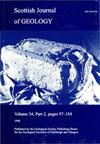A geomorphological reconstruction of the deglaciation of Loch Etive during the Loch Lomond Stadial
IF 0.5
4区 地球科学
Q4 GEOLOGY
引用次数: 7
Abstract
The Loch Lomond Stadial (LLS) (12.9 – 11.7 ka BP) was the last climatic episode in which Scotland possessed a significant ice mass. Loch and Glen Etive represent one of the best-preserved glacial landsystems in western Scotland, having formed a conduit for ice draining from high on Rannoch Moor. Loch Etive is a glacially over-deepened trough 6 km north of Oban, now a sea loch 30 km long and up to 1.5 km wide, extending from the Firth of Lorn NE towards Rannoch Moor. It is a key site in which to understand the glacial processes that shaped the Western Highlands during the LLS, leading to full glacial retreat by 11.4 ka BP. Based on a comprehensive high-resolution multibeam bathymetric sonar survey, the morphology of the seabed was analysed using ArcGIS to create a series of detailed geomorphological maps. Morphological interpretations, backscatter and seismic reflection data from the loch were combined to reconstruct the deglaciation of Loch Etive. The presence of transverse ridges interpreted as recessional moraines and submarine eskers indicates a dynamic glacial retreat from the maximum seaward extent west of the present-day coastline. At its maximum extent, the glacier formed a proglacial delta generating large volumes of meltwater that flowed over the rock sill of the present-day Falls of Lora. The confluence of glacial ice masses, flowing from the Pass of Brander and tributary corrie glaciers, created a complex glaciofluvial environment in the outer basin of Loch Etive. This is reflected in the formation of a large submarine esker. In the inner loch basin, the presence of recessional moraines at intervals suggests a dynamic glacier, responding to seasonal temperature fluctuations, possibly subsequently retreating northeastwards c. 50 m annually as the LLS ended.洛蒙德湖时期埃梯湖冰川消融的地貌重建
洛蒙德湖(LLS) (12.9 - 11.7 ka BP)是苏格兰拥有大量冰块的最后一个气候事件。Loch和Glen Etive代表了苏格兰西部保存最完好的冰川陆地系统之一,形成了一条从Rannoch Moor高处排出冰的管道。埃提湖是奥班以北6公里处的一个冰川过度加深的海槽,现在是一个长30公里,宽1.5公里的海湖,从洛恩东北湾延伸到兰诺克沼泽。它是了解在LLS期间形成西部高地的冰川过程的关键遗址,导致11.4 ka BP的冰川完全退缩。基于全面的高分辨率多波束测深声纳测量,利用ArcGIS对海底形态进行了分析,绘制了一系列详细的地貌图。结合湖泊的形态解释、后向散射和地震反射数据,重建了湖泊的消冰过程。横脊的存在被解释为后退的冰碛和海底冰碛,表明冰川从现今海岸线以西的最大向海范围开始动态退缩。在其最大范围内,冰川形成了一个前冰川三角洲,产生了大量的融水,这些融水流过今天的劳拉瀑布的岩石基座。来自布兰德山口(Pass of Brander)和支流科利冰川(corrie glacier)的冰川冰块汇合在一起,在埃提湖(Loch Etive)外盆地形成了复杂的冰川-河流环境。这反映在一个大型潜艇的形成上。在内湖盆地,每隔一段时间就会出现退潮的冰碛,这表明存在一个动态冰川,它对季节温度波动做出反应,可能随着LLS的结束,每年向东北退缩50米。
本文章由计算机程序翻译,如有差异,请以英文原文为准。
求助全文
约1分钟内获得全文
求助全文
来源期刊

Scottish Journal of Geology
地学-地质学
CiteScore
1.70
自引率
0.00%
发文量
10
审稿时长
>12 weeks
期刊介绍:
Although published only since 1965, the Scottish Journal of Geology has a long pedigree. It is the joint publication of the Geological Society of Glasgow and the Edinburgh Geological Society, which prior to 1965 published separate Transactions: from 1860 in the case of Glasgow and 1863 for Edinburgh.
Traditionally, the Journal has acted as the focus for papers on all aspects of Scottish geology and its contiguous areas, including the surrounding seas. The publication policy has always been outward looking, with the Editors encouraging review papers and papers on broader aspects of the Earth sciences that cannot be discussed solely in terms of Scottish geology.
The diverse geology of Scotland continues to provide an important natural laboratory for the study of earth sciences; many seminal studies in geology have been carried out on Scottish rocks, and over the years the results of much of this work had been published in the Journal and its predecessors.
The Journal fully deserves its high reputation worldwide and intends to maintain its status in the front rank of publications in the Earth sciences.
 求助内容:
求助内容: 应助结果提醒方式:
应助结果提醒方式:


